Eleanor’s story: “I’m not bothered by my birthmark”
Meeting people with visible differences helped Changing Faces campaigner Eleanor open up about her port wine stain birthmark.
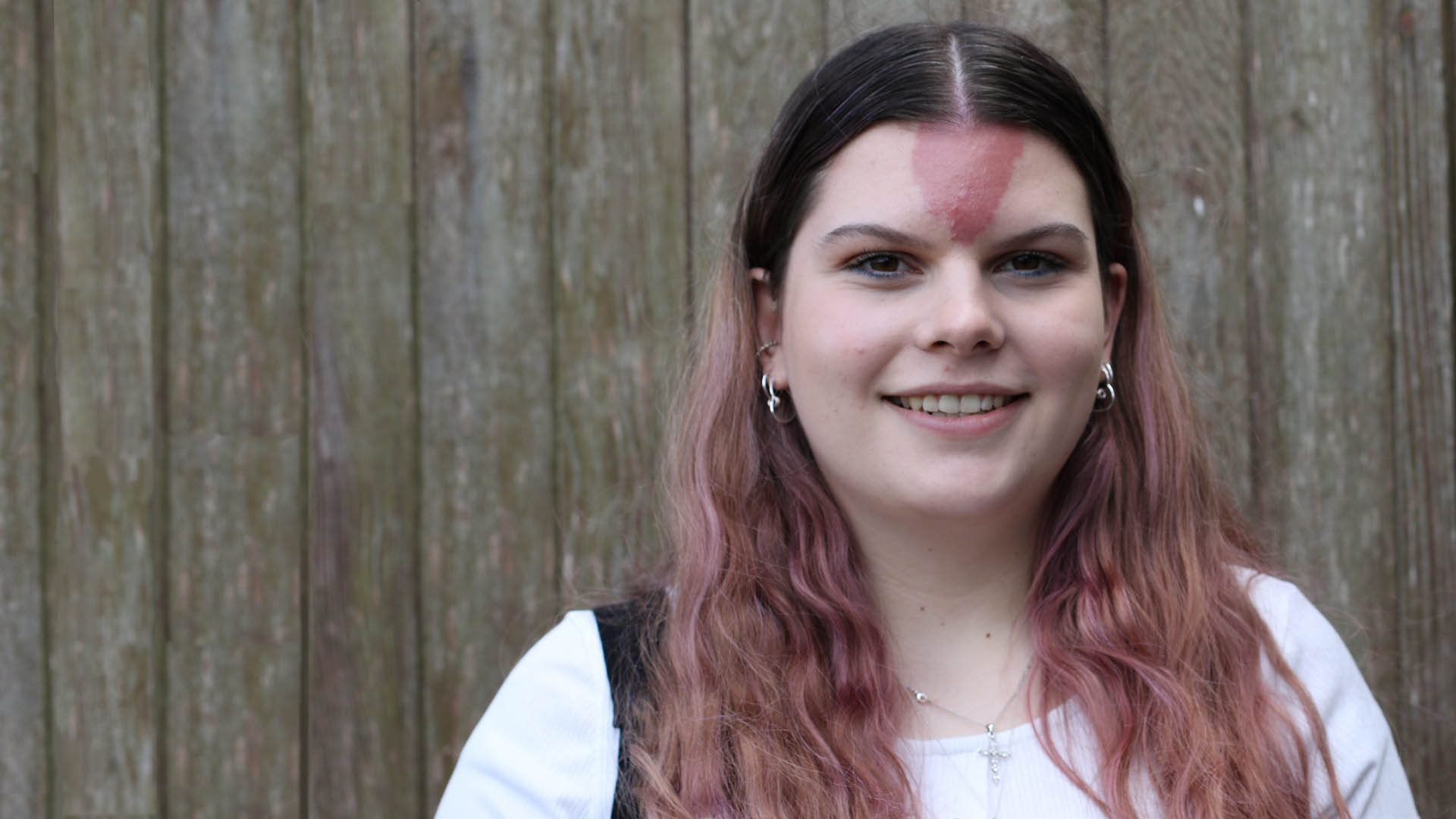
Information about birthmarks, as well as guidance about what support is available from Changing Faces and other organisations.
A birthmark is a coloured mark on the skin which is present at birth or soon after. About one in three babies is born with some kind of birthmark. Most birthmarks are harmless and they often disappear with age and without treatment.
Having a birthmark may affect your confidence or self-esteem. However, many organisations provide support to people living with a birthmark and can help you overcome the challenges you may experience.
On this page, we look at what birthmarks are, explore the different kinds of birthmarks – and discuss ways you can overcome the difficulties you may face if you live with one.
I’ve learned over the last few years that my visible difference cannot stop me from achieving my goals in life and that it doesn’t define me. This empowering feeling led me to want to help others feel the same way.
There are many different types of birthmarks, so we have listed only the most common here. For a more detailed list, please visit the Birthmark Support Group website.
Birthmarks are divided into three main groups:
Here is some more information about the different types of birthmarks and the ways they can be treated. In some cases there may be a medical reason to remove or treat a birthmark, but in general you don’t need to have treatment to change your appearance unless you decide this is the best option for you.
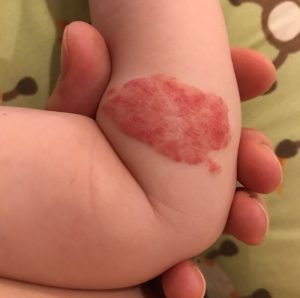
A haemangioma birthmark on white skin (Image by Gstk, CC BY-SA 4.0 via Wikimedia Commons)
Haemangiomas, also known as “strawberry marks”, are the most common type of vascular tumour. They are caused when a group of blood vessels form a lump underneath the skin. Usually, the resulting tumour is the size of a penny or two-pence coin, but they can sometimes grow much bigger. The word “tumour” can sound scary but haemangiomas are not cancerous.
They may have a firm, rubbery feel but can also be soft to the touch.
There are two types of haemangioma:
Haemangiomas occur in one in 10 babies and are more common in girls, premature babies, babies with a low birth weight and multiple births (i.e. twins, triplets etc). They occur most commonly on the head and neck, although they can affect any part of the body.
Haemangiomas appear shortly after birth and tend to grow fastest in the first six to 12 months before gradually shrinking (“involuting”) over the next one to seven years.
A congenital haemangioma is a haemangioma which is fully grown at birth and is often diagnosed during a prenatal ultrasound. They tend to be raised and warm to the touch, and appear pink to blue in colour, with pale skin around them. There are two types:
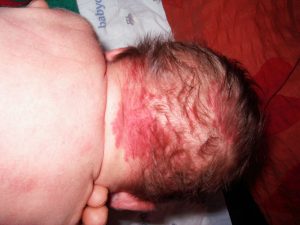
A stork bite birthmark on white skin (Image by Wierzman, CC BY-SA 3.0 via Wikimedia Commons)
Also known as “stork bite”, “salmon patch” or “angel kiss”, this is the most common type of birthmark. Stork bites are pinkish in colour and appear on the forehead, eyelids or the nape of the neck, and may fade under light pressure. Stork bites usually fade by age 2, although those on the nape of the neck may last longer. They tend to disappear without treatment, but laser treatment may be available in some cases. They can be difficult to detect by touch as the skin is not thickened or raised.
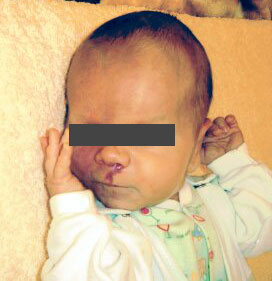
A port wine stain birthmark on brown skin (Image by ArturroD, CC-BY-SA 3.0 via Wikimedia Commons)
More commonly known as a “port wine stain”, capillary malformation is caused by widened capillaries (the smallest blood vessels) and causes a red or purple mark on the skin, most frequently on the face or neck. They usually start out flat and smooth but can become thicker and may be bumpy. About one in every 330 babies is born with a port wine stain and they are roughly twice as common in girls. A port wine stain is diagnosed visually.
Where treatment is chosen, a laser is used to reduce the width of the capillaries and lighten the colour. This is most effective when it takes place early on. It is usually performed at around 6 months of age, before being repeated six to eight times at six to eight-week intervals. Laser treatment works best on the face, neck and chest and less well on the limbs. Treatment rarely removes the birthmark fully and repeated courses are usually needed.
In rare cases, a port wine stain may be connected to uncommon conditions including Sturge-Weber syndrome, Klippel-Trenaunay syndrome and macrocephaly-capillary malformation. Ask your GP about these conditions if you are worried.
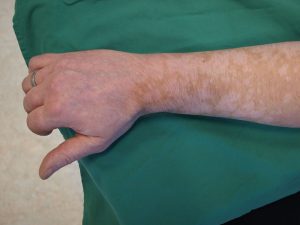
Café-au-lait spots on white skin (Image by Klaus D. Peter, Wiehl Germany, CC BY-SA 3.0 de via Wikimedia Commons)
Café-au-lait spots are flat, smooth, tan-coloured spots which can appear anywhere on the body. They are harmless in themselves and it is quite common to have a few, but if a child has six or more, it is important that they are screened for neurofibromatosis.
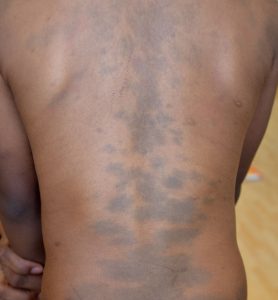
Blue-grey spots on dark-brown skin (Image by Gzzz, CC BY-SA 4.0 via Wikimedia Commons)
Also known as slate-grey nevus or “Mongolian blue spot”, blue-grey spots have the appearance of a bruise and may cover a large area of skin, often on the back, bottom, arms or legs. They are flat with the same texture as the surrounding skin. They are more common in babies with black or brown skin. They usually disappear by age 4.
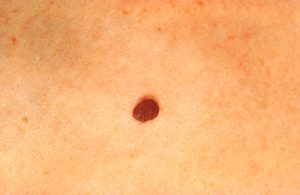
A mole on white skin (Image by National Cancer Institute, public domain via Wikimedia Commons)
Moles are common spots caused by an overgrowth of pigment cells in the skin. They may be flat or raised. In roughly one in a hundred people, one or more moles are present from birth. These are known as congenital moles or, in medical language, “congenital melanocytic naevi” (CMN). Moles may appear anywhere on the body. They are usually harmless, however, there can be an increased risk of moles developing into skin cancer. Contact your GP if they change shape or size. To learn more, have a look at our dedicated page on moles.
Meeting people with visible differences helped Changing Faces campaigner Eleanor open up about her port wine stain birthmark.
Graham has a port wine birthmark on his face. With the support of his family, he has boosted his self-esteem and positivity.
Prisha talks about how sharing her story has helped others and discusses her workplace experiences as a person with a visible difference.
Most birthmarks can appear anywhere on the skin. However some have a tendency to occur in different areas. Certain types of birthmarks are more likely to occur on the face, while others tend to appear elsewhere on the body. Birthmarks in the two vascular groups mentioned above are often found on the head or neck, mainly on the face.
While they can affect any part of the skin:
Although they can appear on any part of the body and also the face:
The root cause of birthmarks is unknown, however, they have not been linked to anything the mother does during pregnancy. They do sometimes seem to run in families.
Birthmarks are usually diagnosed based on a visual check but sometimes a biopsy or ultrasound may be taken. It depends on the type of birthmark and where it is on the body.
Often, birthmarks can be left alone and disappear naturally.
Birthmarks may need to be treated if there is a risk of complications – for example, if they become cancerous. They may also be treated if they are progressing. For example, a port wine stain may be treated early on to stop it getting more pronounced over time. How effective treatment will be depends on the birthmark.
Unless there is a medical reason to have your birthmark treated, many people choose not to have treatment at all. Others decide it is right for them to have a birthmark removed for cosmetic reasons. However, this is not usually available on the NHS.
Birthmarks may affect the appearance very noticeably – such as if they are on the face – or less obviously; for example, if they are on a body part which is concealed by clothing. For some people, this is not a problem. However, for others, having a birthmark can take a significant emotional and psychological toll.
Having a birthmark can make us more self-conscious about our appearance. It can be particularly distressing when others stare, make comments or ask questions – especially if this happens a lot.
It is a pretty regular occurrence that I get stares, and people make comments as well. More often than not I just sort of move on and forget about it but sometimes it can be trickier and it’s not always the most shocking incidents that hurt the most.
If you are struggling, there are a number of support services available for you to access.
Here at Changing Faces, we can offer confidential, one-to-one social, emotional and psychological help through our counselling and wellbeing support sessions. In counselling and wellbeing support, our trained wellbeing professionals will give you the chance to talk through your thoughts, feelings and experiences and provide support and guidance.
We also have a range of self-help guides designed to help you address appearance-related challenges in different aspects of your life. You may want to have a look at our guides on self-esteem and confidence, mental health or browse the entire set here.
You do not have to cover up your birthmark to fit in with so-called “societal norms”. However, some people decide that reducing the appearance of their birthmark is the best option for them. If this is what you have decided, we offer a Skin Camouflage Service which you may find helpful. Our practitioners apply creams and powders to match the colour of the surrounding area. Find out more in this dedicated section of our site.
There are a number of other ways we can support people with birthmarks here at Changing Faces:
If you would like access to our service, please contact our Support and Information Line. As well as sharing information and helping you connect with our services, our friendly team can provide a space for you to talk about the impact of birthmarks on your life.
Guidance, support and advice is also available from other organisations. Please follow the links to their websites to learn more.
The Birthmark Support Group provide information about birthmarks, guidance on managing life with a birthmark and opportunities to share your story to help raise awareness. They also offer advice on how to get a referral and information about UK hospitals which offer specialist support.
BAD specialises in the practice, teaching, training and research of dermatology (the branch of medicine dealing with the skin). They offer patient information on birthmarks, general advice for people with skin conditions and opportunities to take part in research for skin conditions.
A national, highly specialist psychological service based at North Bristol NHS Trust, supporting adults (16+) with appearance-related distress. They can provide face-to-face and remote support via NHS Attend AnyWhere. Please speak to your GP or healthcare professional to discuss a referral.
Please have a look at the NHS condition page for official guidance on the different types of birthmark, information on when to see a GP, and advice about treatments available on the NHS. You will also find out what treatments are available on the NHS and how to seek help.